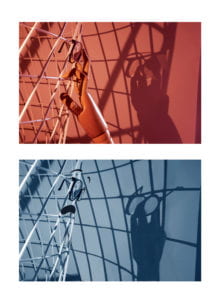A Photograph Two Ways — The Shadow
The Shadow
Concept
The project “The Shadow” is inspired by John Berger’s “Ways of Seeing”. In the book, Berger argues that a woman’s identity is divided into two parts: the “surveyed” and the “surveyor” (46). The part that is “surveyor” observes the part that is “surveyed” by looking at the mirror to make sure that one looks exactly the way she wants others to look at her (Berger 46). Although Berger’s focus is on women, I think the phenomenon applies to all human beings. We are constantly monitoring and adjusting our appearance in order to present to others what we want to present. What’s more, the way we want others to look at us was affected by the outer world and activities — the advertisements, the social media, the education, etc. One’s appearance is largely determined by the outer influences, rather than one’s personality. In this way, we are stripped of our personality and stamped, instead, the “personality” of a culture, a society, or an era. We become the shadow of the world we live in, and we lose control over our own appearance.
Based on this concept, I depicted a man in glasses who is carefully studying his shadow. Instead of photographing a real human being, I used a basket and put glasses on it to create a sense of hollowness and convey the loss of personality. At the same time, I used a wooden hand to imply the illusion of being able to control our own appearance. In the first image, the man is using the wooden hand to adjust his glasses according to the shadow and seems to be controlling his appearance. However, in the second image, the wooden hand is taken away from him and the shadow of the hand starts to pull the glasses off the man’s face. The discovery that his shadow is being manipulated by others startles the man and he shows an expression of shock, which represents the rediscovery of the man’s true self through enlightenment. For the color, I used a warm and vibrant red in the first image to create a feeling of pleasure and enthusiasm that we might gain through making up or dressing up. In the second image, I used a cold blue to express the sadness and fear when the beautiful illusion was destroyed.
Image of the Diptych

1. I arrange the two images vertically to create a sense of downward movement: when our eyes move from the first photo to the second, it looks like the wooden hand is pulled downwards and disappear, whereas the shadow of the hand pulls downward the glasses.
2. I printed the first image with glossy paper and the second with coarse paper. The glossy paper gives a flashy feeling, which represents the flashy appearance we try to present, while the coarse paper indicates the harshness and uneasiness when one comes to realize its vanity.
Process: Staging and Photographing
Object choices: In addition to “The Shadow”, I had experimented on several other topics by combining the wooden hand with different objects. For example, I tried at first to combine the piano with the wooden hand to satirize mechanized practicing. And I also twined wires around the hand to convey a sense of redemption. I made my final choice of objects based on the visual composition and the operability of manipulation.
Lighting choices: I borrowed light sources from the studio and tried to arrange the three-point lighting setup. However, I couldn’t turn off the light in the corridor where I shot my objects, and the extra light source messed up the lighting arrangement. Therefore, I moved into the studio and made the room as dark as possible. By using color papers as light filters, I found the ideal colors for my photo (blue and red).
Contact Sheet

Process: Digital Manipulation
At first, I want to use the Magic Wand Tool to select the wooden hand and delete it. But there were a lot of shadows on the hand which intersected with the patterns on the background, making the selection hard. Then I tried the Lasso Tool and found that after deleting the selected part I had to fill the emptied spaces and handle the zigzagging borders. Therefore, I used the Eyedropper Tool to select the color near the hand and used the Brush Tool to cover the hand with the selected color. I chose the 8th brush in the brush set because it created a soft and blurry border. For the color of the image, I adjusted the Hue/Saturation and Color Balance to create the red and blue tones that I want.
Conclusion
In the first part of the project, I focused on the arrangement of objects and the lighting. But since the objects I shot were all still, I didn’t play with the shutter speed. I’d like to apply a blurry effect to the wooden hand in the future. In the second part of the project, I focused on deleting and adjusting the existing objects. I didn’t add to the photo any new elements (except for the facial expression). I think it would be interesting to adjust the posture of the wooden hand and substitute it for the original one.